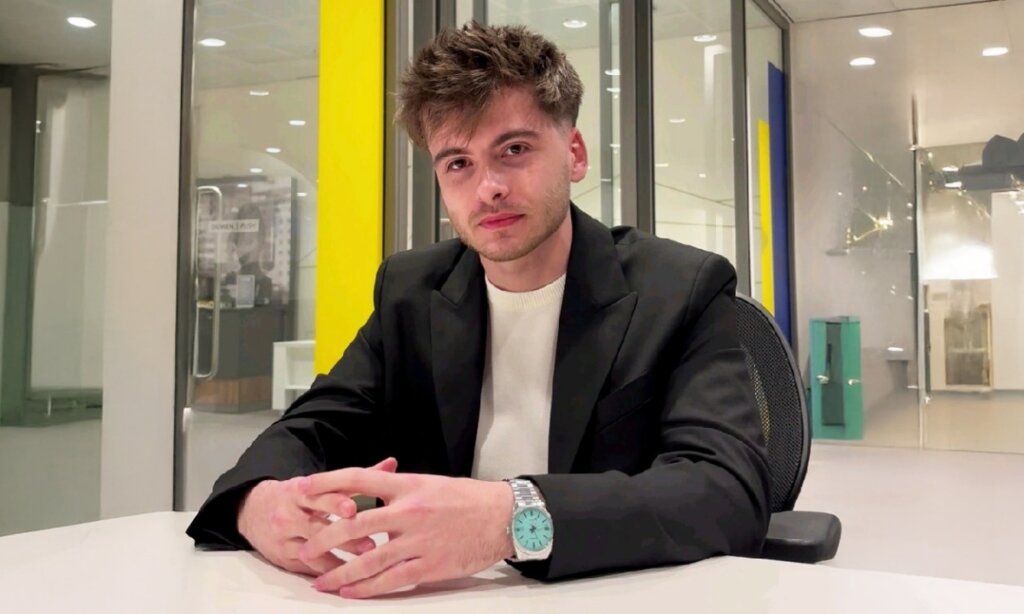Business
Anna Sagan: From Marketing to Woodwork
Published
4 years agoon

Sometimes, our big breaks come when we least expect them. You could be going through the worst time in your life and still find a way back to life and happiness. Anna Sagan is an example of how people can rise beyond their unpleasant situations to become happier with their lives.
Sagan’s Rediscovery Journey
In 2020, when the Covid 19 pandemic was at its worst, many people lost their jobs and livelihoods and had to figure out ways to survive through life. 33-year-old Anna Sagan from Los Angeles was not spared either. The then marketing consultant lost her job and had to make the difficult decision to move home from Chicago to Fayetteville in Arkansas. While living in her parent’s house, Sagan discovered her late grandpa’s tools in the garage. She decided that since she did not have a job, she would keep her mind busy fixing things around the house. Sagan started refurbishing old furniture at home and making wine racks for her friends and family. In her effort to stay busy, Sagan discovered wood art, which has been her passion since then.
She hopes that she can encourage and inspire people with her work. Sagan says that wood art has healing stories and life lessons that she would love to share with the world. She also wants to honor her late grandpa Bill Barta, who she says is a man who left behind his tools and not his spirit.
How Does Sagan Work Around a Project?
Sagan says that she is extremely ADHD, but nothing can stop her once she sets her mind to work on a project. When she is in the woodshop creating something, time passes, and she becomes tunnel-focused. Her mind works tirelessly to finish a project, and she never stops until she has created a masterpiece. When working on larger projects, Sagan likes to use mood boards so that her end goal or vision is always in sight in front of her. She says she does this because she needs that visual reminder to stay aligned and focused. Otherwise, her mind can get distracted.
Sagan says that she has no problem waking up at 4.30 am to start a project, as long as she creates something beautiful. She is deeply motivated by comments from her friends and clients about her work. She says that the looks and sounds of admiration push her to become better at her career.
Does Sagan Have Any Life Outside Woodwork?
When asked this question, Sagan had this to say, “I’m a big fan of wine. I geek out on trying new varietals and discovering new regions and wine-making methods. It’s truly an art form that I feel people find intimidating because of the industry and false perceptions that our culture has taught us about it.”
Sagan says that while the woodwork is a great experience for her, almost like a rebirth, getting involved in other arts such as wine tasting is a great way to unwind. It also helps to keep her artistic instincts alive.
Common Myths About the Wood Work Career
Sagan says she has also suffered from the misconception that woodwork is a simple skill that doesn’t require hard work. She says she only realized how challenging the career was until she got into it. Woodwork requires the same amount of patience and persistence that not everyone has the mental capacity to do. She says that even though she has become accustomed to the career, there are times she doubts herself and her ability to complete a project.
Source of Inspiration
Sagan’s most significant source of inspiration is Marie Forleo, the author of “Everything is Figuratable.” The book helped her breakthrough a mindset limiting her from pursuing her dreams. She says that the biggest lesson she has learned in her career is that it is never about how much money a person brings home or what other people think you should be doing. The most important thing is for a person to be doing the one thing that brings them happiness, peace, and fulfillment.
Biggest Challenge At Work
Sagan says that it is very disappointing to say that her femininity is the biggest challenge around her career. Being a woman somehow limits her from achieving career achievements for herself. She says that at one time, when she was working with a woodwork company, one of the men asked her if she was the cleaning lady because he could not envision a woman doing woodwork.
Sagan has missed out on numerous opportunities because people think that a woman is not good enough to be working in the industry. She recalls a time when she lost her job because she was a distraction to her colleagues. This was not because she did anything intentionally or was indecently dressed. It was just because she was a woman.
If you would like to get in touch with Sagan for inspiration or buy from her, reach her on her blog, website, Instagram, TikTok, and YouTube.
This article contains branded content provided by a third party. The views expressed in this article are solely those of the content creator or sponsor and do not necessarily reflect the opinions or editorial stance of Popular Hustle.

You may like
Business
Young Romanian Entrepreneur Explores Lisbon’s Thriving Startup Scene
Published
2 weeks agoon
November 24, 2025
There’s a certain kind of clarity that comes from stepping outside your comfort zone. For Darius Borda, a young Romanian entrepreneur, that moment arrived in Lisbon, where he spent months collaborating with André Marquet, founder and CEO of Productized. What started as an exploration of Portugal’s tech ecosystem turned into something more concrete: the groundwork for his next business venture.
Borda didn’t just observe. He participated. He got involved in startup accelerators, the Productized Conference, the EUDIS Defence Hackathon, and the Lisbon GenAI Meetups, an exclusive community of AI specialists. It’s the kind of immersive experience that can’t be replicated from a distance.

“I came to Lisbon curious about entrepreneurship,” Borda said. “I left with new connections and the confidence to take the leap on my new business venture. Collaborating with André Marquet and being surrounded by people creating and launching their ideas was the best kind of learning.”
The collaboration worked both ways. Marquet found value in Borda’s IT management background and business instincts. “Collaborating with Darius Borda has been highly valuable,” Marquet noted. “His IT management expertise was essential to the organization of the Productized Conference, and his strong business acumen enabled meaningful deep-dives into entrepreneurial opportunities of mutual interest.”

Beyond the formal events, the real work happened in conversations about defence tech, entrepreneurship, and early-stage startup ideas. Those discussions haven’t ended. There’s talk of future collaborations, though nothing’s set in stone yet.
The experience gave Darius Borda something he didn’t have before: a clearer sense of what’s next and the foundation to build on it. Sometimes that’s what you need. Not answers, just enough clarity to start.
Business
Leading With Purpose: How Dr. Rasheda Jackson is Redefining Success for Women in Business
Published
3 weeks agoon
November 15, 2025
Dr. Rasheda Jackson, crowned the 2025 Ms. Woman Entrepreneur International, is an award-winning author, serial entrepreneur, and international speaker whose work continues to redefine what it means to lead with purpose. As the Founder of RJ Enterprises and Owner of Be Free Tax and Business Consulting, a firm that has thrived for over 17 years, she has built an empire grounded in empowerment, integrity, and transformation. In addition to leading her own companies, Dr. Jackson serves as the COO for a multimillion dollar brand, providing strategic oversight that fuels continued growth and innovation as well as fractional Exec for 2 others.
Her literary accomplishments include authoring over eleven books, contributing to anthologies, and publishing numerous e-books such as Empowered by His Purpose and What to Do While You Wait. Her voice and expertise have been featured in Voyage Miami, Inspire Magazine, Unique Access, Canvas Rebel, and platforms like Womanish on Urban.TV and the Amazon documentary Dumpster Diving.
What sets Dr. Jackson apart is her authenticity. Having risen from the challenges of teenage parenthood to the heights of international recognition, she embodies resilience and leadership in action. She uses her platform to inspire others, particularly women, to exceed boundaries, embrace confidence, and build businesses rooted in faith and strategy. Her story proves that where there is vision, discipline, and divine purpose, transformation is not only possible but inevitable.
Beyond her professional accomplishments, Dr. Jackson is a devoted mother and grandmother whose faith and family remain at the core of her mission. She believes that success without service is incomplete, and her companies reflect that conviction. Whether she is coaching entrepreneurs through RJ Enterprises or guiding business owners through Be Free Tax and Business Consulting, her purpose remains the same: to help others achieve true freedom through knowledge, structure, and strategy.
With an expanding global influence, Dr. Jackson continues to be a leading voice in business empowerment, blending education, innovation, and faith to help others build lasting legacies that honor their purpose and potential.
Building a Business That Sets People Free
Be Free Tax & Business Consulting stands out because it was built with a mission far beyond numbers. It is about freedom, education, and second chances. I founded the company to create real opportunities for single parents, veterans, and individuals who needed a fresh start. That purpose-driven foundation still guides everything we do today.
Unlike traditional tax firms that focus only on compliance, Be Free Tax blends financial expertise with holistic business consulting. We help entrepreneurs build strong structures, maintain financial health, and position themselves for long-term growth, not just tax season survival. Our goal is to make business ownership accessible, profitable, and sustainable for everyday people.
Education is at the heart of our model. We do not just prepare taxes; we teach clients how to understand them. Through workshops, e-books, and personalized consultations, we empower business owners to make informed decisions that increase profit and reduce stress. This commitment to teaching creates confident clients who know how to keep more of what they earn.
What also makes us different is our heart. Be Free Tax is built on empathy, integrity, and innovation. We combine cutting-edge systems and technology with genuine care and transparency. Our clients know they are not just a number; they are part of a community built to grow and thrive together.
At Be Free Tax, success is not defined solely by financial results but by the freedom and confidence our clients gain. That is what makes us unique. We do not just handle taxes; we help people and businesses be free.
Standing Out in a Crowded Market
In an industry where everyone promises expertise, I differentiate Be Free Tax & Business Consulting by leading with purpose, education, and authenticity. My company was never built just to prepare taxes; it was built to help people create freedom. From single parents and veterans to individuals seeking a second chance, my mission has always been to empower others to build wealth and independence through knowledge and structure.
What sets Be Free Tax apart is that we do not just execute services, we educate. I believe an informed client is an empowered client, so we provide workshops, resources, and one-on-one consulting that teach business owners how to understand their finances, maximize profits, and stay compliant. That commitment to education builds trust and long-term success, not dependency.
I also differentiate my brand through authenticity. I am transparent about my journey, the lessons learned, and the systems that work. People connect with honesty, and that human touch is what makes our firm relatable and reliable. Clients do not just see us as accountants, they see us as partners in their progress.
Technology plays a key role as well. While many firms rely solely on automation, we combine innovative systems with personal service. This balance allows us to be efficient without losing the relationship-driven experience that clients value most.
Finally, I focus on building community. Be Free Tax is not just a company, it is a movement centered on freedom, growth, and second chances. By creating spaces for entrepreneurs to connect and learn together, we extend our impact far beyond the office.
Lessons in Leadership
Running a business has taught me that leadership is less about control and more about capacity, the capacity to adapt, to listen, and to lead with vision even when the path is not clear. Over the years, I have learned that every obstacle in business reveals a lesson in leadership, and every challenge is an invitation to grow stronger, wiser, and more strategic.
The first lesson is that people come before profit. True success happens when you invest in your team, your clients, and your community. Building relationships rooted in trust, communication, and shared purpose will always produce sustainable results.
Second, I have learned the power of resilience and adaptability. Markets shift, systems change, and seasons evolve, but a strong leader remains flexible while staying grounded in their values. Leadership requires the ability to pivot without losing direction.
Third, I have learned that vision is the anchor. A leader must consistently cast the vision, communicate it clearly, and align others with it. Without vision, strategy becomes motion without meaning.
Finally, I have learned that leadership is stewardship. It is about managing not only resources but also influence, using your platform to empower others and create opportunities. Every decision should advance both purpose and people.
These lessons have shaped my leadership philosophy: lead with clarity, serve with integrity, and grow through every challenge. The greatest leaders are not those who avoid difficulty, but those who transform it into direction.
The Power of Coaching and Clarity
When I started my first business, I learned quickly that passion without guidance can lead to burnout. Having a coach is not just helpful, it is essential. Every entrepreneur needs someone who can see the full picture, ask the right questions, and help turn vision into strategy. That is why I believe so deeply in coaching, because I have seen how it changes lives and accelerates success.
Through Be Free Tax & Business Consulting and RJ Enterprises, I have had the privilege of coaching countless entrepreneurs who started with a dream but needed direction. A good coach helps you avoid the pitfalls that stall so many startups, from choosing the wrong structure to mishandling finances or skipping foundational steps. Coaching bridges the gap between inspiration and execution.
As a strategist, I do not just tell people what to do, I help them understand why it matters. My approach focuses on clarity, accountability, and mindset, because success in business starts with how you think. The right coach helps you see beyond today’s challenges and prepares you to build something sustainable for the future.
Entrepreneurship can be lonely, but coaching creates connection. It provides the support, structure, and wisdom every new business owner needs. I always tell my clients: you do not have to figure it out alone.
A coach is not an expense; it is an investment in your growth, confidence, and clarity. With the right guidance, you do not just build a business, you build a legacy.
A Season of Growth and Expansion
The past three months have been a powerful season of expansion and impact. I have poured my experience, strategy, and heart into creating resources that help entrepreneurs build businesses that truly work.
I officially launched my new group coaching program, “10 Steps to Start a Business That Works,” a hands-on experience designed to help aspiring entrepreneurs move from idea to execution with clarity and confidence. This program brings together everything I have learned from nearly two decades in business, practical tools, accountability, and mindset shifts that turn vision into results. It is more than coaching; it is a blueprint for freedom and foundation.
Alongside the program, I released my latest book by the same name, 10 Steps to Start a Business That Works, which serves as both a guide and a companion for those ready to take bold action. Every page reflects my belief that business success begins with strategy, structure, and the right mindset.
And because I believe growth does not stop at business, it begins within, I am also preparing for my upcoming 2026 retreat titled Business Minding: Resetting the Mind to Move into MORE. This retreat will be a transformative experience focused on mental renewal, spiritual alignment, and strategic clarity for leaders ready to elevate to their next level.
For those who want a preview of the movement, my new masterclass is now live at SolidBizStart.com, offering a front-row look at the principles that have built my businesses and guided countless others toward success.
This season is about stepping boldly into MORE, more purpose, more alignment, and more freedom.
What’s Next for Dr. Jackson
In the next couple of months, the 10 Week Cohort will officially begin, and I could not be more excited. This immersive experience will guide entrepreneurs step by step through launching, structuring, and scaling their businesses. Everyone can join the waiting list or learn more at SolidBizStart.com.
Contact Information
Email: drrasheda@iamrasheda.com
Websites: www.befreetax.com and www.iamrasheda.com
Facebook: https://www.facebook.com/rashedaj2
Instagram: @befreetax
LinkedIn: linkedin.com/in/DrRashedaJackson
Skool: https://www.skool.com/business-skool
Business
HundRoses Is Building a Dating App Where You Can’t Message Anyone Without Proving You’re Real
Published
1 month agoon
October 30, 2025
Online dating has a trust problem. You match with someone, start a conversation, and three messages in you’re wondering if you’re talking to the person in the photos or someone running a script from a call center overseas. Fake profiles, catfishing, bots posing as humans. It’s exhausting. HundRoses, a dating platform in development for Canadian and American users, has a straightforward solution: make people prove they’re real before they can send a single message.
Here’s how it works. You can browse profiles without any verification, scroll through potential matches, and get a feel for the app. But the moment you want to actually talk to someone, verification is required. It’s a hard line that most dating apps won’t draw, but HundRoses is prioritizing safety over convenience.
The verification requirement only for messaging is smarter than forcing everyone through it upfront. People want to explore before committing, and there’s no point making someone verify their ID just to see if the app even has users in their area. But once you’re interested enough to reach out, proving your identity becomes part of the process. It’s the difference between casual browsing and genuine engagement.

This approach directly addresses what makes online dating feel unsafe for a lot of people. Women deal with harassment, fake accounts, and people who aren’t who they claim to be. Men waste time talking to bots or scammers. Everyone’s been ghosted by someone who was probably never real in the first place. Verification raises the floor. If someone has to verify their identity to message you, you know there’s an actual human on the other end. That baseline level of accountability changes how people interact from the first conversation.
The platform calls itself a dating app “built around respect and trust,” and the verification system backs that up. It’s not just a tagline or marketing language. It’s baked into how the app functions at its core. You can’t operate anonymously when it comes to making connections, which changes the dynamic from the start. There’s a real person behind every message, and both people know it.
HundRoses is launching in Canada and the USA, targeting North American singles who are tired of the same recycled experiences from Match Corporation’s family of apps. They’re currently offering early access to VIP members while the platform’s still in development, building a user base that values verified connections over anonymous browsing. The focus on Canadian and American markets gives them a contained launch to refine the experience before considering expansion.
The verification barrier separates people who are serious about meeting someone from those who just want to browse without accountability. For users fed up with fake profiles and dead-end conversations, that barrier is exactly the point. It filters out the noise before it even starts.
Dating apps have spent years trying to make everything as frictionless as possible, removing any obstacle between swiping and messaging. HundRoses is adding friction back in, but only where it matters. Browse all you want, but if you’re going to reach out to another person, you’re doing it as yourself.
Learn more at HundRoses.com or follow their development on Instagram, Facebook, X, and LinkedIn.



Nodust Writes His Lyrics Last and That’s Exactly the Point

Finding Strength in Walking Away Is the Real Message Behind Judy Pearson’s New Single

Joaquina’s “Freno” Captures the Push and Pull of Letting Go

Young Romanian Entrepreneur Explores Lisbon’s Thriving Startup Scene

Electric Ferries Will Save Money But Harbors Can’t Afford Them, Says Harbor Current Foundation Inc.

Leading With Purpose: How Dr. Rasheda Jackson is Redefining Success for Women in Business

The Quarantined Release ‘Aversion To Normalcy,’ An Album Born From War and Survival

Coastal Harmony: Discovering Cyprus with Lordos Beach Hotel as Your Haven

Meet Kaziboii, the Afrobeats Artist Mixing Drill Energy With Vibrant Soul

LBE Scar on His Two EPs, Loyalty, Fatherhood, and Opening for Bone Thugs-N-Harmony

HundRoses Is Building a Dating App Where You Can’t Message Anyone Without Proving You’re Real

Camden Harris Proves the Future of Music and Business Lives in Vision, Not Noise

Levi Lobo Takes the Lead in New Mexico Indie Thriller “The Weight Of It All”

Nicole Ariana Confronts Her Demons on Emotional New Single “Return to Sender”

Billiards Legend Allison Fisher Teams with Producer Monty Hobbs on TV, Books, and Brand Expansion

Jason Luv Dominates Charts While Inspiring New Wave of Multi Career Artists

Harley West | Inside the Mind of a Social Media Star on the Rise

Raw Fishing | Franklin Seeber, Known As “Raww Fishing” Youtuber Story

Jordana Lajoie Transforms Montreal Roots into Hollywood Success Story

A New Hollywood Icon Emerges in Madelyn Cline

Who is Isaiah Silva – The Story Behind The Music

Tefi Valenzuela Pours Her Heart into New Song About Breaking Free

G FACE Releases His New Single “All up,” and It’s Fire

Kaia Ra | Perseverance That Built a Best-Selling Author

Gearshift to Stardom: Nikhael Neil’s Revolutionary Journey in the Automotive Industry

Holly Valentine | Social Media Influencer & Star Success Story

Kate Katzman | Breaking Into Hollywood and Embracing Change

Tadgh Walsh – How This Young Entrepreneur is Making a Name for Himself

Thara Prashad | Singer Evolves to Yoga & Mediation Superstar

King Lil G | West Coast Hip Hop Genius Rises to Face With Ease

Tefi Valenzuela Pours Her Heart into New Song About Breaking Free

Kate Katzman | Breaking Into Hollywood and Embracing Change

Holly Valentine | Social Media Influencer & Star Success Story

Kaia Ra | Perseverance That Built a Best-Selling Author

Lil Ugly Baby XXX’s “Who?” – The Mixtape to Boost Your Playlist

Samuel Chewning Explains How Fitness Should Be A Personal Journey

Trending
-

 Business4 years ago
Business4 years agoJason Luv Dominates Charts While Inspiring New Wave of Multi Career Artists
-

 Entertainment2 years ago
Entertainment2 years agoHarley West | Inside the Mind of a Social Media Star on the Rise
-

 Culture4 years ago
Culture4 years agoRaw Fishing | Franklin Seeber, Known As “Raww Fishing” Youtuber Story
-

 Culture2 years ago
Culture2 years agoJordana Lajoie Transforms Montreal Roots into Hollywood Success Story
-

 Culture1 year ago
Culture1 year agoA New Hollywood Icon Emerges in Madelyn Cline
-

 Entertainment11 months ago
Entertainment11 months agoWho is Isaiah Silva – The Story Behind The Music
-

 Entertainment2 years ago
Entertainment2 years agoTefi Valenzuela Pours Her Heart into New Song About Breaking Free
-

 Culture3 years ago
Culture3 years agoG FACE Releases His New Single “All up,” and It’s Fire

